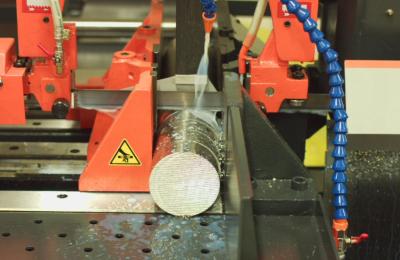
Cosen band saws with V_Drive are modern solutions for cutting aluminum efficiently. The most popular include Cosen Saws G320 and C-Series Horizontal band saws which many of our customer use to cut different grades of aluminum. With V_Drive technology, band saws are now able to cut harder denser materials like titanium, hastelloy, and other nickel based metals at significantly increased rates. With aluminum, these machines focus on generating high blade speed with the correct combination of horsepower and torque within the gearbox and motor, so that even at high speeds the machine is not overworked and can still provide excellent cuts. Cosen’s band saws combined with big tooth blades create the right amount of clearance when cutting common types of aluminum, including 6061, 6063, 6070, and more making them the ideal solution for metal fabrication and steel service centers.
Cosen Saws G320 features a hydraulic dual column design and a capacity of 12.8" x 15". It is one of the smartest saws available right now and features Smart NC-100 (SNC-100) technology and V_Drive built in. SNC-100 controls are programmable up to 100 different jobs including quantity and length of cut. The controls automatically compensate for Kerf loss after data input and requires no manual calculation of number of times to index. This saw is the perfect solution for cutting a wide variety of material, including aluminum. Saws with the same technology and larger capacities are also available with Cosen’s C-Series Horizontal Band Saws.
For more traditional solutions, Cosen’s Circular Series offers specifics models designed to cut non-ferrous metals, such as aluminum and copper. The saw’s blade runs at an extremely high speed which makes it one of the fastest cutting machines on the market. Cosen’s non-ferrous machines help fulfill customer needs in a precise and efficient manner, resulting in fast cutting, tight tolerance, and a great finish. Cosen Saws Circular Series consists of the CC-100 and CC-150. These two CNC Automatic circular saws provide a round capacity of up to 6.338" and come equipped with an automatic-bar loading system. These saws are great for high volume jobs and for those cutting aluminum all day long.
When comparing different types of saws, consider that advances in band saw technology have helped expand options for cutting aluminum. Band saws provide a good solution for those looking to cut aluminum over 6" in diameter and for those who are interested in being able to cut a wide variety of materials alongside their aluminum production. Band saws also enable a smaller capital investment in sawing aluminum and allow companies to reduce their footprint. Another benefit includes band saw blades being thinner than those of circular saw blades, this leads to less kerf loss and provides a faster return on investment.
Contact Details
Related Glossary Terms
- bandsaw blade ( band)
bandsaw blade ( band)
Endless band, normally with serrated teeth, that serves as the cutting tool for cutoff or contour band machines.
- centers
centers
Cone-shaped pins that support a workpiece by one or two ends during machining. The centers fit into holes drilled in the workpiece ends. Centers that turn with the workpiece are called “live” centers; those that do not are called “dead” centers.
- circular saw
circular saw
Cutoff machine utilizing a circular blade with serrated teeth. See saw, sawing machine.
- clearance
clearance
Space provided behind a tool’s land or relief to prevent rubbing and subsequent premature deterioration of the tool. See land; relief.
- computer numerical control ( CNC)
computer numerical control ( CNC)
Microprocessor-based controller dedicated to a machine tool that permits the creation or modification of parts. Programmed numerical control activates the machine’s servos and spindle drives and controls the various machining operations. See DNC, direct numerical control; NC, numerical control.
- kerf
kerf
Width of cut left after a blade or tool makes a pass.
- sawing
sawing
Machining operation in which a powered machine, usually equipped with a blade having milled or ground teeth, is used to part material (cutoff) or give it a new shape (contour bandsawing, band machining). Four basic types of sawing operations are: hacksawing (power or manual operation in which the blade moves back and forth through the work, cutting on one of the strokes); cold or circular sawing (a rotating, circular, toothed blade parts the material much as a workshop table saw or radial-arm saw cuts wood); bandsawing (a flexible, toothed blade rides on wheels under tension and is guided through the work); and abrasive sawing (abrasive points attached to a fiber or metal backing part stock, could be considered a grinding operation).
- sawing machine ( saw)
sawing machine ( saw)
Machine designed to use a serrated-tooth blade to cut metal or other material. Comes in a wide variety of styles but takes one of four basic forms: hacksaw (a simple, rugged machine that uses a reciprocating motion to part metal or other material); cold or circular saw (powers a circular blade that cuts structural materials); bandsaw (runs an endless band; the two basic types are cutoff and contour band machines, which cut intricate contours and shapes); and abrasive cutoff saw (similar in appearance to the cold saw, but uses an abrasive disc that rotates at high speeds rather than a blade with serrated teeth).
- tolerance
tolerance
Minimum and maximum amount a workpiece dimension is allowed to vary from a set standard and still be acceptable.
